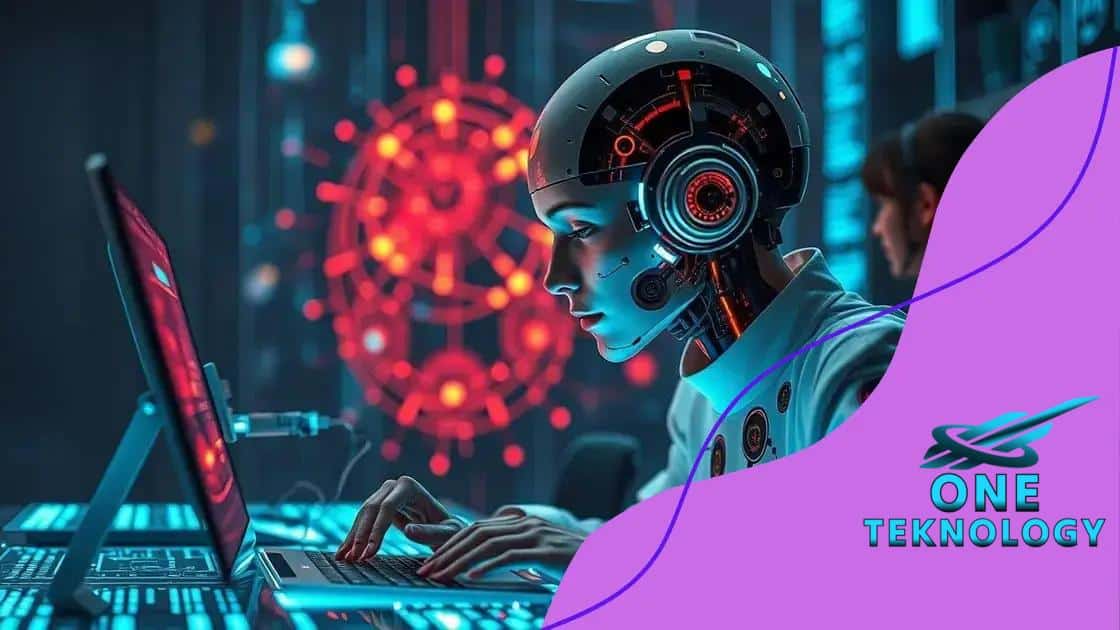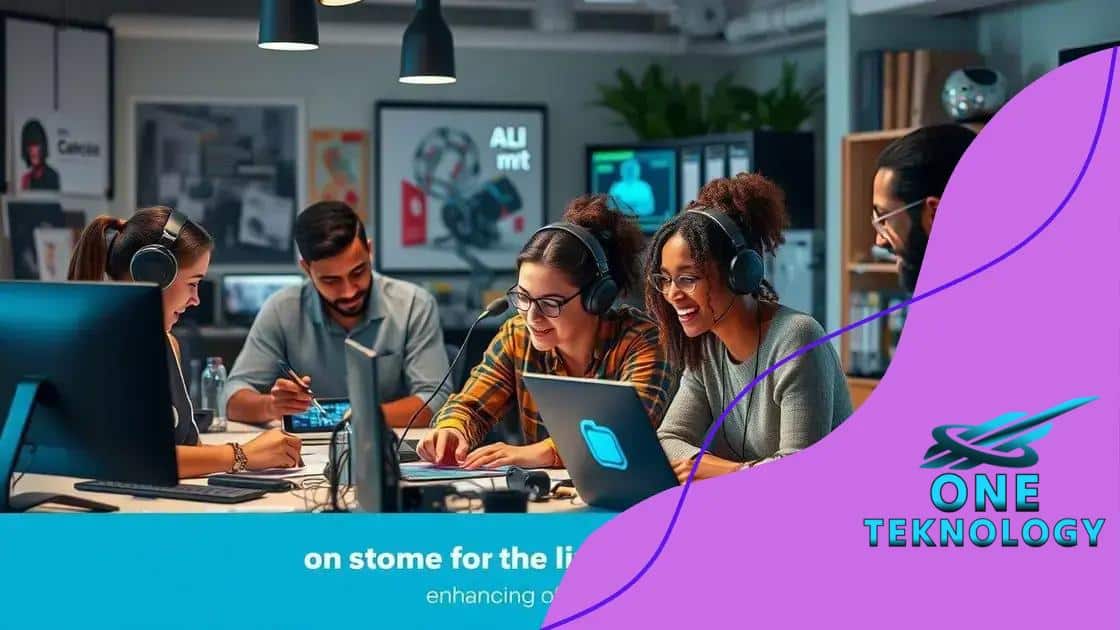The role of AI in transforming the creative industries

The role of AI in transforming the creative industries involves enhancing creativity, personalizing experiences, and streamlining workflows, while also presenting ethical challenges that artists must navigate.
The role of AI in transforming the creative industries is becoming increasingly pivotal. Have you noticed how technology is reshaping artistic expression and collaboration? Let’s dive into this fascinating evolution!
Understanding AI’s impact on creativity
Understanding AI’s impact on creativity is crucial for artists and creators today. As technology evolves, it opens new doors for creative expression and collaboration. With AI tools, artists can push boundaries and explore uncharted territories.
How AI Enhances Creative Processes
AI technology can take over repetitive tasks, allowing creators to focus on what they do best—imagination. For instance, AI can help in:
- Generating ideas based on existing artworks.
- Streamlining design processes with automated suggestions.
- Assisting in music composition by offering chord progressions.
This technology doesn’t replace creativity; instead, it complements and enhances it, leading to exciting fusions of art and technology. Furthermore, AI can analyze data to provide insights into current trends, helping artists stay relevant.
Collaborative Opportunities with AI
AI fosters collaboration between humans and machines, creating unique partnerships. Artists are beginning to view AI as a co-creator capable of bringing novel perspectives. Many are experimenting with:
- Interactive installations where art reacts to audience inputs.
- AI-generated imagery that serves as inspiration for traditional artwork.
- Collaborative music where AI partners with musicians to produce fresh sounds.
These partnerships are not just about convenience; they’re about enhancing the human experience of art. As artists work with AI, they discover new forms of expression that challenge their traditional boundaries.
In conclusion, understanding AI’s impact on creativity allows us to appreciate its potential. As we embrace these technologies, the future promises to be an exciting canvas of innovation and inspiration.
Case studies: AI in art and design
Case studies showcasing AI in art and design reveal the profound changes this technology brings to creative fields. Artists and designers are finding innovative ways to collaborate with AI, leading to unique outcomes that challenge traditional artistic boundaries.
Renowned Artists Embracing AI
Many famous artists are now using AI tools to enhance their work. For example, Mario Klingemann is known for using neural networks to create stunning visual art. His pieces often blur the line between human creativity and machine learning. Similarly, Refik Anadol combines data and AI to create mesmerizing installations that alter how we experience art.
- Klingemann’s work exemplifies AI art generation by transforming data into expressive visuals.
- Anadol’s immersive installations engage audiences through real-time data visualization.
- These artists show that AI can serve as a medium for expression rather than a replacement for the human touch.
As these artists experiment with AI, they inspire others to explore this technology’s potential. The results of their collaborations spark dialogue about art’s future and how technology shapes it.
Innovative Design Projects Utilizing AI
In the design world, AI is increasingly used for creating everything from architecture to product design. One noteworthy project is the work of Zaha Hadid Architects, which uses AI algorithms to enhance architectural designs. Their designs reflect a seamless integration of technology and creativity.
- AI assists in data analysis to improve design efficiency.
- It helps in generating structural forms that traditional methods might miss.
- Designers can visualize complex concepts thanks to AI-driven simulations.
A different example comes from fashion, where designers are using AI for predicting trends based on consumer data. Brands can stay ahead by utilizing these insights, leading to customized collections tailored to audience desires.
These case studies demonstrate the transformative role of AI in art and design. By using AI, creators are not only enhancing their work but also challenging the way we perceive creativity today.
AI tools enhancing creative workflows

AI tools enhancing creative workflows are revolutionizing how artists and designers approach their projects. These tools are designed to streamline tasks, allowing creators to focus more on innovation and creativity rather than repetitive work.
The Role of Automation
Automation is a key feature of AI tools. For instance, they can handle tasks such as:
- Image editing by suggesting adjustments or applying filters.
- Generating design mockups based on user inputs.
- Analyzing trends to provide data-driven insights.
By automating these tasks, artists can save valuable time and effort. This allows them to shift their focus to ideation and experimentation, resulting in more innovative outcomes.
Collaboration with AI
AI tools also enhance collaboration among creative teams. Platforms that use AI can help teams work more effectively by offering features like:
- Real-time feedback on designs or concepts.
- Cloud storage solutions that allow easy sharing of files.
- AI-driven project management tools that keep teams aligned on deadlines and goals.
This collaboration fosters a shared understanding and encourages diverse ideas, essential in any creative process. As a result, teams are better equipped to produce high-quality work that resonates with their audience.
Moreover, the integration of AI tools into workflows leads to the exploration of new creative avenues. Artists can experiment with various styles and techniques that they may not have considered before. For example, AI can analyze an artist’s previous works and suggest styles or elements to explore further.
As these tools continue to evolve, the relationship between humans and AI will deepen, creating new possibilities in the artistic landscape. By embracing these enhancements, artists and designers pave the way for a more dynamic and engaging creative future.
Challenges of AI in creative fields
Challenges of AI in creative fields are important to consider as technology advances. While AI offers many benefits, it also brings unique obstacles that artists and designers must navigate. Understanding these challenges can help creators utilize AI effectively while preserving their artistic integrity.
Ethical Concerns
One major challenge is the ethical implications of using AI in creative work. For example, questions arise when AI generates art or music:
- Who owns the rights to AI-generated content?
- How do we credit AI creators alongside human artists?
- Can AI-generated works truly reflect human emotion or intent?
These questions require careful consideration to maintain fairness and respect in the creative community. The balance between using AI for assistance and relying on it too heavily must be managed.
Maintaining Creative Authenticity
Another challenge involves maintaining the authenticity of creative expression. Some artists worry that using AI tools may lead to a loss of unique style or personal touch. As technology performs tasks previously done by humans, there is a fear that:
- Art might become formulaic, lacking individual flair.
- Originality could suffer if artists depend on AI suggestions too heavily.
- Cultural narratives may be diluted as AI lacks personal experience.
To combat this, artists must find ways to use AI as a tool, not a crutch. Balancing technology and personal creativity is essential for preserving artistic integrity.
Additionally, the fast-paced development of AI can be intimidating. Artists may feel overwhelmed by the constant changes and improvements in technology, leading to hesitation in adapting new tools. Embracing new AI capabilities requires a willingness to learn and adapt.
Ultimately, navigating the challenges of AI in creative fields demands a thoughtful approach. By addressing ethical concerns, ensuring authenticity, and embracing technology mindfully, artists can find a harmonious balance that elevates their work without compromising their creativity.
Future trends of AI in the creative industries
Future trends of AI in the creative industries are shaping how art, design, and media are created and consumed. As technology evolves, artists and creators will find new ways to integrate AI into their work.
Personalized Experiences
One major trend is the rise of personalized experiences powered by AI. For instance, AI algorithms can analyze user preferences and tailor content to individual tastes. This customization can be seen in:
- Curated playlists in music streaming services.
- Personalized recommendations for art exhibitions based on viewer history.
- Custom fashion items designed using AI data on trends and customer preferences.
This shift allows creators to connect with their audience on a deeper level, making experiences more engaging and relevant.
Integration of Virtual and Augmented Reality
Another exciting trend is the integration of AI with virtual reality (VR) and augmented reality (AR). These technologies enhance creativity by creating immersive environments for artists to explore and design. For example, artists can:
- Create virtual galleries that provide alternative ways to view art.
- Use AR apps to visualize designs in real-world settings.
- Develop interactive storytelling experiences that engage users on multiple levels.
As these technologies advance, they will open up new avenues for artistic expression, allowing creators to push the boundaries of their fields.
Additionally, AI will continue to improve the creative workflow through better collaboration tools. Artists will be able to share their work with others instantly and receive instant feedback driven by AI analysis. This real-time interaction will facilitate a more dynamic creative process. Furthermore, machine learning will enhance tools to provide predictive insights, helping artists make informed decisions during their projects.
As the landscape of AI in the creative industries evolves, artists and designers must remain flexible and adaptive. By embracing these trends, they can leverage technology to enhance their unique voices and expand their creative horizons.
FAQ – Frequently Asked Questions about AI in Creative Industries
What are the main benefits of using AI in creative work?
AI enhances creativity by automating repetitive tasks, allowing artists to focus on innovation and new ideas.
How can AI personalize experiences for audiences?
AI analyzes user data to tailor content and recommendations, making experiences more engaging and relevant.
What challenges do artists face when integrating AI?
Artists must navigate ethical concerns and ensure that their authenticity and voice are not diminished by reliance on AI.
How do AI tools improve collaboration among creative teams?
AI tools facilitate real-time feedback and project management, helping teams work together more effectively and efficiently.






